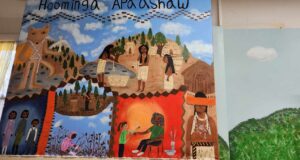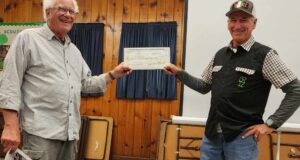75 Years of Range Research –
As we of the north Highway 41 area head south or north to and from the Fresno area, we pass the San Joaquin Experimental Range (known as SJER) just north of Road 406, the Daulton-Bates Station Road. Curiosity about the use and history of this area that has been in operation since 1934 got the best of this writer—so here is the story in their words.
The SJER is California’s first range research station and is a field location of the US Forest Service Pacific Southwest Research Station. For the past [78] years…the “Range” has been the site of a wide variety of biological and management studies by [USFS] and cooperating scientists from a number of state and federal agencies, organizations and universities. The SJER site was chosen as representing several million acres of annual type (fall germination, rapid spring growth and maturing in late spring) range lands in California. [The land is described] as “being of medium value and reflected many of the unresolved problems of the seasonable variables and nutritive deficiencies of beef cattle.”
The SJER is approximately 4,500 acres in size and has been grazed by cattle since the beginning. An exception is the Research Natural Area which has been ungrazed and unburned since 1934. Other non-grazed areas have been added over time. Animal husbandry, range improvement (fertilization, re-seeding, brush control, etc.), wildlife habitat, botanical and zoological studies have been the main research products. The information gained from these studies has influenced management practices for beef cattle, rangelands and wildlife in California.
During its lifetime, the “Range” has been heavily used as an example of the annual-type range and its management for producer field days, visits by university classes from California and other western states, foreign visitors and agency training. Advisory Committees have been established at various time periods to provide input into research activities and to maintain communications with the livestock industry and cooperating agencies.
During the first 25 years (1934 to 1959-60): Reflecting the economic climate of the time, the use of the Civilian Conservation Corps (CCC) to construct the buildings, fencing, corals, watering locations and other required facilities for research provided the physical foundation for station activities. The Work Projects Administration (WPA) also contributed to art work, historical information and help with rodent studies. The headquarters buildings were constructed with adobe bricks manufactured from the site.
Over these first 25 years, the California universities cooperated with the Forest Service regarding livestock and plant research. The report covers 75 years of study (to 2009), the first, second and last 25 years. The report was published by the University of California and is 6 pages long (plus the cover). If anyone would like to have a copy faxed to them, please email Kay Good at chs@sti.net I would be happy to send this history on to interested people.
Just a thought: perhaps the Coarsegold Historical Society could arrange to have a tour of the area….



